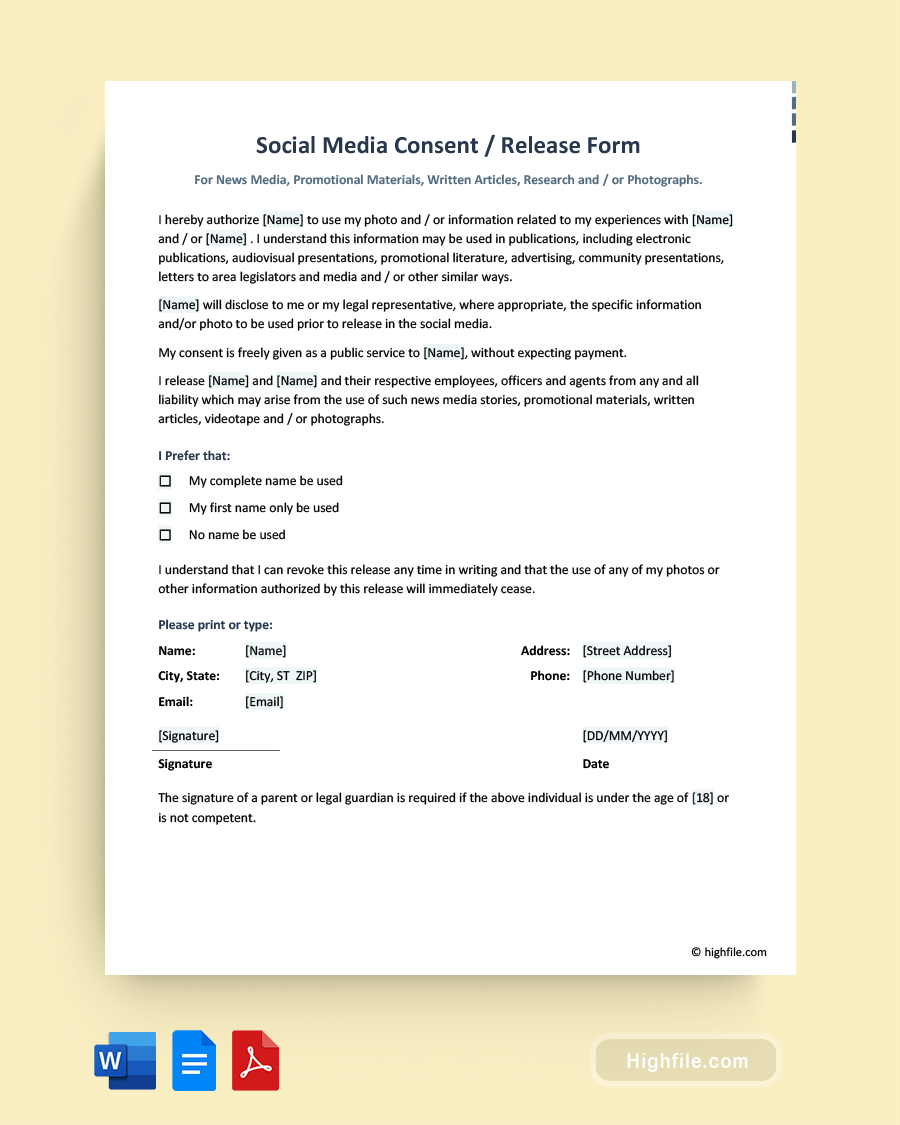Social media is an essential part of modern life, with billions of people worldwide using it to stay connected, share information, and promote their businesses. Unfortunately, with all the potential for misuse, it is vital to ensure that users know the rights and responsibilities of using your platform. Creating a social media consent form is an easy way to ensure that users and anyone you feature understand how their content, such as pictures and videos, will be used. We recommend using our professionally designed templates to ensure your consent forms have everything you need to post the content you create online without concerns.
This article will cover everything you need to know about social media consent forms. You’ll learn why this document is essential and how to create one for your business, organization, or personal page, plus tips, tricks, and frequently asked questions. With the right information, you can protect your platform and provide users with a safe, legal environment for engaging with your content.
What Is a Social Media Consent Form?
A social media consent form is a legal document that outlines the terms under which you will use the content of your followers and customers. Even if you have established an excellent relationship with your current fanbase and are trusted by your community, you should still make a social media consent form to protect yourself and your brand from potential lawsuits. By creating a social media consent form, you can create a legal contract between you and your subjects to protect yourself from any allegations of defamation or abuse.
Why is Social Media Consent Form Important?
Social media has become an integral part of many people’s daily lives. Sadly, this popularity has led to many potential legal issues related to the content posted on social media platforms. The ease with which people can post information online and, in some cases, the potential reach of this content has led to several lawsuits and even investigations into public figures such as celebrities and politicians. Many of these issues could be avoided by ensuring that all users know their rights and the expectations around their content. By creating a social media consent form, you can lay out exactly what you plan to do with the user’s content and provide them with the opportunity to give consent.
How Does a Social Media Consent Form Work
A social media consent form is a fundamental document ensuring your content is above board, and everything you post is legal. It covers you for liability and helps your subjects understand their rights regarding your posts about them or containing their image. Giving people a social media consent form makes them feel respected and helps build trust in your brand. Moreover, it prevents anyone from saying later that you posted their private images and other data without consent. Once signed, you can post your content without worrying that the subjects will complain, demand you remove content, or sue for damages.
Essential Elements of a Social Media Consent Form
The essential elements of a social media consent form are there to ask for permission before posting images, videos, or other personal information about people. Below we’ve created a simple outline that shows what you should include and where it belongs on the page. We’ve added a few optional sections to help elevate your consent form to the next level and improve it.
- (Optional but Highly Recommended) Company or Brand Logo- Creating a brand means having a simple, identifiable logo people always associate with your content.
- Title- Your form should have the words “Social Media Consent Form” in large bold print at the top, so there’s no way to mistake what the document is intended for.
- (Optional) Definition of Terms- This section is standard on lengthier contracts, but you can include it here. The definition of terms should consist of an explanation of the key terms and phrases used in the social media consent form to prevent confusion about whether you mean something different than what you mean.
- Authorization and Consent Statements- These lines should state clearly that (subject) gives (you/business/organization) permission to share their image, videos, or other experiences on social media. Additionally, it should state clearly that they give this consent freely with the understanding that (you/business/organization) are not liable for the response.
- (Optional) Remuneration Information- Whether you are paying or not, make it clear exactly what the subject can expect.
- Name Consent- Name consent should be a series of checkboxes allowing the subject to have their full name, first name, nickname, or no name included with your public information and posts.
- (Optional but Recommended) Rights Granted- This section should provide an accurate and detailed explanation of what you will and will not do with the user’s content.
- Opt-Out- Include a link to any content preferences or opt-out mechanism that is provided. This allows the user to easily opt out of the shared content without having to contact you at any specific time. You can also use a simple statement that says they can opt-out in writing.
- (Optional) Other Information- You may want to leave space for any additional details or information that you feel is important.
- Name and Contact Information- This is self-explanatory. Have the subject print their name, address, phone, and email details.
- Signature and Date Lines- The signature and date are what make this form a legal contract. Please note that you may want to leave space for a secondary line for parents or guardians if your posts include minors, as they cannot consent themselves unless they’re emancipated.
Tips for Writing a Better Social Media Consent Form
Making your social media consent form the best it can be is important. We’ve collected some smart tips to help you create an excellent form that will encourage, but not coerce, people to let you use their images, build trust and make your brand stand out.
- Be Formal- It is important to remember that legal documents are always written formally and carefully.
- Research Your Audience- Next, you will want to conduct some research on your audience to learn more about their social media use habits and preferences. This will allow you to understand what types of content they like to see, get an idea of the types of social media platforms they are active on, and discover their preferred method of communication. By learning more about your audience, you can tailor your social media consent form to best meet their needs.
- Create a Survey- After conducting your research, you will better understand how your users prefer to interact with your social media content. Doing this lets you create a survey you can give your current fanbase to gauge their thoughts on your content. Creating a survey with questions about your content can also help prevent issues related to surveys that could negatively affect your brand.
- Cover Your Bases- The consent form should be comprehensive and clear so users can understand it. Companies should explain the types of data they are collecting, why they are collecting it, how they will use it, and how long they will retain it.
- Let People Say No- Provide a clear opt-out option so users can withdraw their consent anytime.
Best Practices for Creating a Social Media Consent Form
Although consent forms are nothing new, social media has given rise to a new set of laws and potential pitfalls. Here are some tips for best practices to help keep your company, page, or brand out of trouble and build a better reputation.
- Build Trust With Your Followers- Building trust with your followers and community will help make certain they trust your social media consent form. To do this, you will want to engage with your community regularly, post high-quality content, and respond to any messages they send within reason.
- Be transparent- A social media consent form will help you stay transparent. It is important to remember that social media consent forms are legally binding contracts and should be treated as such. Therefore, you must remain as straightforward as possible to avoid any issues or issues with your content being misused. Be careful to provide honest content that doesn’t make any false claims. By staying as transparent as possible, you can avoid confusion or issues that arise from misused content.
- Read the TOS- When using a platform, always read the Terms of Service thoroughly to know what you can and cannot post. When updates come out, read those too. If you aren’t sure you understand the terms, please ask the site administration or an attorney for clarification.
- Respond to Legitimate Concerns Promptly- Once you have completed your social media consent form, you will want to respond to any concerns your subjects have. It’s best to resolve any issues or questions quickly so people understand their rights and responsibilities. Doing this can also help prevent any problems arising from your social media consent form.
- Stay up-to-date- Staying up-to-date on the latest changes in the social media landscape is critical to ensuring that your social media consent form is as current and relevant as possible.
- Don’t Feed the Trolls- Troll is a commonly used term for people online who post to create drama and get a rise out of people or businesses. Although you should respond to genuine messages, the best thing to do with trolls is ignore them. Failing to get the attention and engagement they want from you will force them to move on.
FAQs
Many companies and individuals still do not use social media consent forms, even though they should. We’ve provided more information on some of the most frequently asked questions about this topic to help you understand them better. Here you’ll find details about online consent, why you need social media consent forms, and whether you (or someone you post about) could have content about them taken down.
If you plan on using social media to promote your business or products, you will need consent from your customers, clients, friends, or family when using their likeness or image in your social media posts. However, if you’re using social media to communicate with your customers, fans, or clients, you likely don’t need a consent form. In short, it depends on how you plan on using social media. Whenever you use images or videos of other people, you should assume you need their consent.
There are a few different factors you need to consider when creating an online consent form, such as the type of data you’re collecting and the purpose of the collection. You also need to make sure that your consent form is clear and concise and that individuals have the right to withdraw their consent at any time. When using an online consent form to gather sensitive information, it is crucial to ensure that the document is legally binding. Otherwise, you may not be able to use the information you collect.
In most cases, you can’t force someone to take down an image from their social media unless it violates the terms of service of the platform or it’s against the law. For example, if the image is pornographic or shows you in a compromising situation, you may be able to get it taken down. If you’re just concerned about someone posting an unflattering photo of you, you may be out of luck. In general, people have the right to post whatever images they want of you, as long as they’re taken in a public setting and not violating any laws. When images are newsworthy or are being used for commentary or criticism, it is unlikely that you will be able to have them removed. If you want to try to get images removed from social media, you should contact the site administrator and explain your situation.
When you’ve been photographed or recorded without your consent, you may be able to have the images, videos, or other personal information removed from social media. In some (rare) cases, you may also be able to sue for damages from the person who posted the compromising or upsetting images. It is important to note that there are limited circumstances where you can get images or videos taken down. We recommend consulting an attorney to see if you have legal recourse.
Final Thoughts
Social media consent forms grant you, your business, brand, or organization permission to use photos, videos, experiences, and names of your subjects on your platform. By having people sign a simple consent form, you are protecting yourself or your business from legal liability arising from posting this content online. Although it may be challenging to have the content removed in some cases, sensitive information and private images are protected by law. Using a professional template to create your social media consent form will help you quickly and efficiently make a custom consent form for your social media. Use the tips and information in this article to help make your consent form the best it can be.







